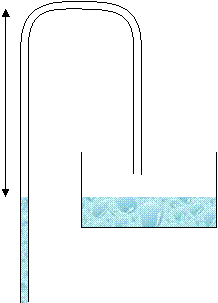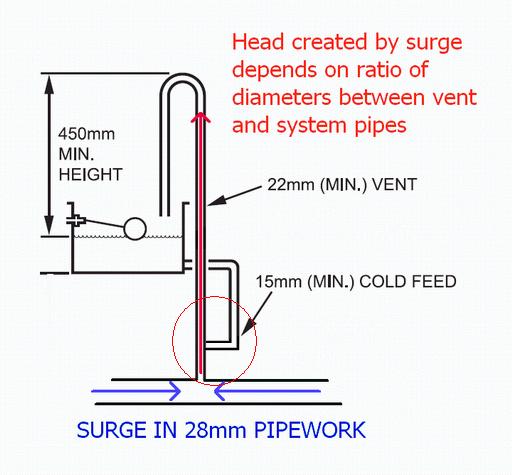In another post of mine we were trying to resolve a problem where air was briefly getting sucked into the primary whenever the pump started. Having verified the correct layout of pump, feed and vent many people have been scratching their heads trying to figure out why the air gets in (in addition, a quantity of water is ejected from the open vent whenever the pump stops).
I now think I understand what the problem is, but I'm not finding any discussion about it and it's gone right over the heads of all the plumbers that have been called to invetigate. What is slightly unusual (but by no means unique) about my system is that it is mostly run in 28mm pipework. The vent pipe, however, is 22mm diameter all the way from the inlet of the pump up to the F/E tank a few meters above.
I'm no hydraulic engineer so I look to professionals for advice and information. Nowhere can I find recommendations about matching the diameters of these pipes, but what seems inevitable (and is actually happening) is that the velocity of the water moving between these components is amplified by the change in diameter. Why is water moving in the vent? Because (it seems to me) when the pump stops or starts, the flow can't instantly stop or start. That would be physically impossible.
From observation, a brief surge is created up the vent whenever the pump stops (I'm guessing there is a degree of rebound off the stationary pump?) and the difference between the diameters of the vent and main system pipework amplify the velocity of the water by a factor of 1.6 (the ratio of the two cross sectional areas of the pipes). This seems to have been enough to push a quantity of water up and out of the narrower vent pipe.
Also from observation (and symmetrically consistent) a quantity of water is momentarily sucked down from the head in the vent when the pump starts. With the narrower vent pipe, this quantity appears to be enough to allow air to be introduced with it as well.
So I'm left wondering why I can see no recommendation bout matching vent pipe diameter - although I have seen plenty of "fixes" involving combining vent and feed - and a "fix" involving the insertion of a wide section of vent etc. (mostly related to low head installations). I'm very curious to know what the professionals think about this which is why I have started this dedicated discussion topic
I now think I understand what the problem is, but I'm not finding any discussion about it and it's gone right over the heads of all the plumbers that have been called to invetigate. What is slightly unusual (but by no means unique) about my system is that it is mostly run in 28mm pipework. The vent pipe, however, is 22mm diameter all the way from the inlet of the pump up to the F/E tank a few meters above.
I'm no hydraulic engineer so I look to professionals for advice and information. Nowhere can I find recommendations about matching the diameters of these pipes, but what seems inevitable (and is actually happening) is that the velocity of the water moving between these components is amplified by the change in diameter. Why is water moving in the vent? Because (it seems to me) when the pump stops or starts, the flow can't instantly stop or start. That would be physically impossible.
From observation, a brief surge is created up the vent whenever the pump stops (I'm guessing there is a degree of rebound off the stationary pump?) and the difference between the diameters of the vent and main system pipework amplify the velocity of the water by a factor of 1.6 (the ratio of the two cross sectional areas of the pipes). This seems to have been enough to push a quantity of water up and out of the narrower vent pipe.
Also from observation (and symmetrically consistent) a quantity of water is momentarily sucked down from the head in the vent when the pump starts. With the narrower vent pipe, this quantity appears to be enough to allow air to be introduced with it as well.
So I'm left wondering why I can see no recommendation bout matching vent pipe diameter - although I have seen plenty of "fixes" involving combining vent and feed - and a "fix" involving the insertion of a wide section of vent etc. (mostly related to low head installations). I'm very curious to know what the professionals think about this which is why I have started this dedicated discussion topic







